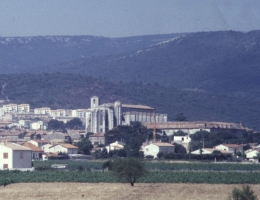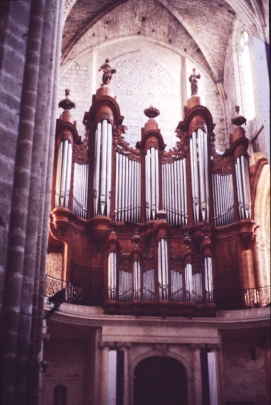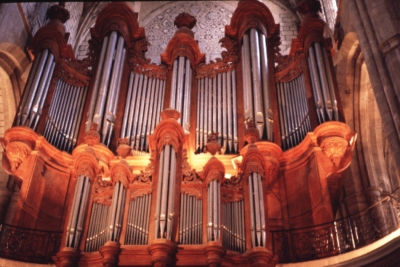

St. Maximin en Var
|
| Disposition | Photographs |
Introduction The Basilica of Mary Magdalene in St. Maximin-en-Var is a huge edifice that dominates the
surrounding village and flat countryside. The structure was begun in the late thirteenth
century according to a plan by Pierre d'Angicourt. Construction continued in fits and starts
for over 200 years, and the last bays were completed only in 1532. In 1772, when the organ was
built, the basilica was part of a Dominican Monastery, which the monks were forced to leave
during the revolution a few years later. After the revolution the basilica was restored to
religious life as a parish church. The budget allowed the organ to be maintained, but not
modernized, which resulted - - happily enough - - in its preservation. In spite of some minor
changes (including a modern pedalboard), the organ remains a monument of organ-building in late
eighteenth-century France.
The Basilica of Mary Magdalene in St. Maximin-en-Var is a huge edifice that dominates the
surrounding village and flat countryside. The structure was begun in the late thirteenth
century according to a plan by Pierre d'Angicourt. Construction continued in fits and starts
for over 200 years, and the last bays were completed only in 1532. In 1772, when the organ was
built, the basilica was part of a Dominican Monastery, which the monks were forced to leave
during the revolution a few years later. After the revolution the basilica was restored to
religious life as a parish church. The budget allowed the organ to be maintained, but not
modernized, which resulted - - happily enough - - in its preservation. In spite of some minor
changes (including a modern pedalboard), the organ remains a monument of organ-building in late
eighteenth-century France.
The organ was built by Jean-Esprit Isnard, a builder who was active in southern France from
about 1740 until the 1770's. Although he built instruments from Toulouse to Aix-en-Provence,
only the St. Maximin organ remains today in an almost unaltered state.
|
| Top of Page | Disposition | Photographs |
DispositionIn some respects the Isnard organ at St. Maximin is typical of the French Classical Organ. There are three manual divisions, Grand Orgue, Positif and Récit, with this disposition. |
| Grand Orgue (C - c"',d"') | Positif (C - c"',d"') | Récit (c - c"',d"') | |||||
|---|---|---|---|---|---|---|---|
| Montre | 16 | Montre | 8 | Cornet V | |||
| Bourdon | 16 | Bourdon | 8 | Trompette | 8 | ||
| Montre | 8 | Flûte | 8 | Hautbois | 8 | ||
| Bourdon | 8 | Prestant | 4 | ||||
| Double Nazard | 5 1/3 | Nazard | 2 2/3 | ||||
| Prestant | 4 | Doublette | 2 | ||||
| Double Tierce | 3 1/5 | Quarte | 2 | ||||
| Grande Fourniture II | Tierce | 1 3/5 | |||||
| Petite Fourniture IV | Larigot | 1 1/3 | |||||
| Cymbale IV | Fourniture | III | |||||
| Dessus de cornet V | Cymbale | III | |||||
| Trompette | 8 | Dessus de cornet V | |||||
| Clarion | 4 | Trompette | 8 | ||||
| Dessus de trompette en chamade | 8 | Clairon | 4 | ||||
| Voix humaine | 8 | Cromorne | 8 | ||||
|
The stops are unremarkable, and for the most part fit the pattern one would expect in a
Classical French organ. The lack of a 4' Flûte is not surprising on an Grand Orgue of
only fourteen stops, and at this point in the development of the French organ, the presence of a
5 1/3' in its place is not unheard of. Similarly, the two reeds on the
Récit were found on earlier organs, although most imstruments had only one of them.
There are other real innovations here, however.
|
| I. | II. | ||||
|---|---|---|---|---|---|
| Flûte | 16 | Dessus de flute | 8 | ||
| Flûte | 8 | Dessus de trompette en chamade | 8 | ||
| Flûte | 4 | Dessus de cornet V | |||
| Bombarde | 16 | ||||
| 1ere trompette | 8 | ||||
| 2e trompette | 8 | ||||
| Clarion | 4 | ||||
If you look at the stops of this division as constituting a single manual division, they mark a
radical departure from the classical tradition in France. However, it is possible to consider
them as simply rearrangements of traditions of long-standing in France:
|
| Top of Page | Disposition |
PhotographsYou can make a selection from the choices below to see enlargements of the photographs of the Isnard organ that appear on this page. You will have to use your browser's "back" button to return to this page.
|
© 2000 AD James H. Cook
 The case is typical of the French Classical organ in keeping all the pipes of the main
case at one level. Its unusual width, comprising five towers separated by flats of pipes, is
the result of changes made in the original plan for the instrument, which called for an 8' organ
of more modest dimensions. The embracing curve of the main case - - seen more clearly in the
second photograph - - gives it a visual interest that prevents it from appearing to be merely a
vast wall in the building.
The case is typical of the French Classical organ in keeping all the pipes of the main
case at one level. Its unusual width, comprising five towers separated by flats of pipes, is
the result of changes made in the original plan for the instrument, which called for an 8' organ
of more modest dimensions. The embracing curve of the main case - - seen more clearly in the
second photograph - - gives it a visual interest that prevents it from appearing to be merely a
vast wall in the building.